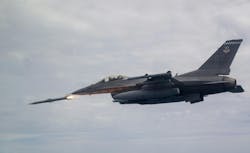Air Force orders several hundred AMRAAM radar-guided air-to-air missiles for U.S. and allied air forces
EGLIN AIR FORCE BASE, Fla. – U.S. aerial warfare experts are asking RTX Corp. to build several hundred medium-range air-to-air missiles under terms of a $1.2 billion order announced earlier this month.
Officials of the U.S. Air Force Life Cycle Management Center at Eglin Air Force Base, Fla., are asking the RTX Raytheon segment in Tucson, Ariz., for production lot 38 of the AIM-120 Advanced Medium Range Air to Air Missile (AMRAAM).
AMRAAM is an active radar-intercept missile with inherent electronic protection capabilities for air-to-air applications against massed penetration aircraft. AMRAAM has been in service since 1991, and was designed to replace the AIM-7 Sparrow radar-guided air-to-air missile.
This order adds additional production of the AMRAAM missiles, AMRAAM telemetry system, initial and field spares, and other production engineering support hardware and activities.
This contract involves foreign military sales to Bahrain, Bulgaria, Canada, Finland, Germany, Hungary, Italy, Japan, Norway, Switzerland, Ukraine, and the United Kingdom. Each AMRAAM lot roughly consists of 400 to 500 missiles.
Since AMRAAM lot 32, Raytheon AMRAAM production has involved missiles that integrate the form, fit, function refresh of the AMRAAM guidance section, which seeks to mitigate the effects of parts obsolescence and diminishing manufacturing sources in the missile's guidance section.
The U.S. Air Force and Navy AMRAAM is one of the nation's most sophisticated radar-guided air-to-air missiles, and one of the world's most advanced all-weather, all-environment, medium-range air-to-air missiles for engaging enemy aircraft and missiles from beyond visual ranges.
Mitigating the effects of obsolescence and diminishing manufacturing sources can involve the substantial redesign of subsystems by replacing electronic chips and other components that the original manufacturers no longer can produce.
In 2015 Raytheon experienced technical difficulties with the AMRAAM application-specific integrated circuit (ASIC) design, hardware integration, and guidance section performance demonstration, which delayed the program's critical design review for a year.
In January 2017 Raytheon officials announced a project to develop a new signal processor for the AMRAAM under the F3R project to help ensure AMRAAM production through the end of the 2020s.
On this order Raytheon will do the work in Tucson, Ariz., and should be finished by December 2028. For more information contact RTX Raytheon online at www.rtx.com/raytheon.
About the Author
John Keller
Editor-in-Chief
John Keller is the Editor-in-Chief, Military & Aerospace Electronics Magazine--provides extensive coverage and analysis of enabling electronics and optoelectronic technologies in military, space and commercial aviation applications. John has been a member of the Military & Aerospace Electronics staff since 1989 and chief editor since 1995.
